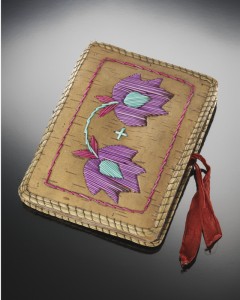While browsing through the online collections on the National Museum of the American Indian, I came across this beautiful Anishinaabe (Chippewa/Ojibwa) Bible cover made sometime around 1880-1900. Now, as an Ojibway myself, I am particularly fond of it. Look at those colors! The flowers are just beautiful. What is particularly interesting about the cover is that it uses birchbark, porcupine quills, and sweetgrass – all traditional, pre-contact Anishinaabe materials for making and decorating things. The floral motif is also a part of Ojibway art history and culture (and is very much part of our contemporary identity). Florals were developed/embraced by Native people, steeped in natural tradition/respect, and influenced Victorian florals, Persian rugs, and the like (which were contemporary to their time – the whole thing can get academic, but if you’re interested in ideas about the development of florals check out Ruth Phillips’ book Trading Identities: The Souvenir in Native North American Art from the Northeast, 1700-1900). Anyway, it’s a gorgeous, elegant example of Ojibway art. (See the NMAI entry for this quilled birchbark Anishinaabe (Chippewa/Ojibwa) Bible)
To think about this Bible cover further, the artist, whoever she may have been (I say she since women frequently primarily engaged in this type of birchbark/quillwork art), took an established form of a European Bible (which at that time would likely be leather-bound) and in essence, Indigenized it for an undeniably Ojibway result. I’m sure the Bible was very precious to her or whoever else it may have been made for. What else can be done when designing an object with Native cultural influences in mind?
I got to explore this idea myself, as related to books, while I was going to Oregon State University. At one point, I was taking a photography class at the same time that I was taking a packaging design course. The latter course really opened my mind to exploring and shaping the form of an object, and it ended up influencing the first class. I had taken some photographs at a pow wow and needed to figure out how to present them, so I decided to go in a hand-made book format. I ended up making the cover imitative of the fringed shawls of female fancy dancers – the cover was fringed in the same manner as a shawl I was working on for a friend. It was a fun experiment, and overall I’m happy with the result.
Got an example of a cool Native-styled book? Let me know!

